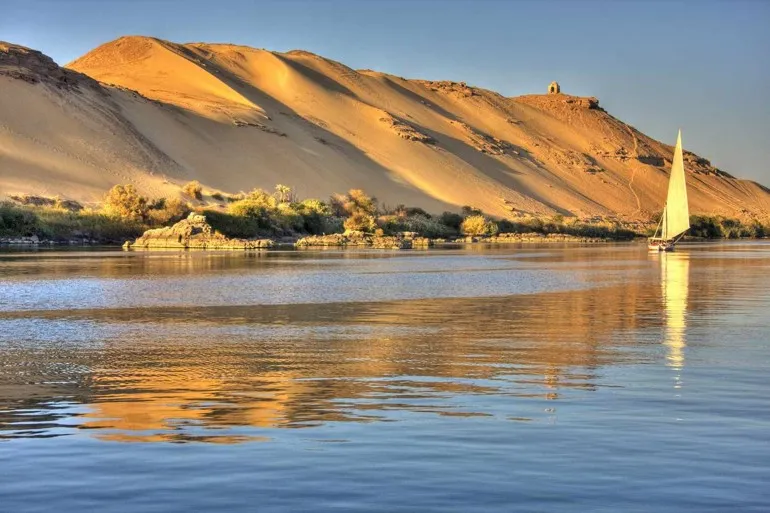Recent News

10
Jan
History Of Nilu
The Story of the Nile
FACTS ABOUT THE NILE:
"Egypt is the gift of the Nile" is an old saying that has spontaneously crossed the minds of most people around the world, without paying attention or realizing its true meaning. To grasp the significance of this saying, one must recognize what the Nile River truly is.
THE HISTORICAL ROLE OF THE NILE:
In ancient times, primitive Egyptians settled along the banks of the Nile, where they built simple houses and huts for accommodation, cultivated many crops, and domesticated some animals. This marked the first steps toward Egyptian glory. Agriculture was the starting point, as the Nile overflowed, carrying silt deposits that covered the neighboring lands along the Nile Valley and made them fertile. Wheat was the first crop cultivated by ancient Egyptians, who relied on the Nile's floods as a solution to hunger and food scarcity. On the other hand, animals like water buffalo and camels were used for food, plowing, and transporting goods. In short, the Nile was essential for people, crops, and livestock. Gradually, most Egyptians moved to the Nile Valley, where they could secure food. As ancestors congregated on the Nile's banks, they created ancient Egyptian civilization, one of the greatest civilizations in ancient history. It witnessed the construction of many temples and tombs filled with precious treasures and jewelry. The Nile's influence extended to Sudan, where it significantly contributed to the rise of Sudanese kingdoms.
RELIGIOUS FACTS ABOUT THE NILE:
As part of the ancient Pharaohs' religious life and their insistence on creating many gods and goddesses for natural elements, they honored the Nile by creating Sobek, the "God of the Nile," also known as the "Crocodile God." This deity, represented as a man with the head of a crocodile, symbolized fertility, wetlands, medicine, and sudden death. The Nile was considered the sweat of Sobek. Another deity associated with the Nile in ancient Egypt was "Hapy," called the "Lord of the River Bringing Vegetation" or the "Lord of Fish and Birds of the Marshes." Hapy was the god of the Nile's annual floods, which greatly controlled water levels and symbolized fertility. The floods carried rich silt to the Nile Valley lands, aiding agriculture. Another role of the Nile in ancient Egyptian life was dividing the ancient calendar into three seasons, each consisting of four months: "Akhet" represented the flood season when the Nile overflowed, "Peret" was the growing season when the Nile enriched the soil with silt, and "Shemu" symbolized the harvest season during the dry period.
THE NILE’S HISTORY AND ITS AGRICULTURAL AND ECONOMIC ROLE:
Since the Nile was the best way to document the ancient Egyptian civilization in history, it also became the sacred secret of success in other fields. Agriculture was the first activity that laid the foundation for the Egyptian empire. When the Nile overflowed, the water level rose, carrying rich silt deposits and flooding the valley lands, making them more fertile. Ancient Egyptians used the flood period to cultivate crops for their needs. They later relied on some domesticated animals to assist with farming tasks. These animals considered the Nile their permanent refuge, where they found water. On the other hand, the Nile served as a bridge for people and goods, especially among the Nile Basin countries. In ancient times, the people used primitive wooden boats to trade goods via the Nile. Nowadays, large ships are used. These exchanges contributed to economic progress, making the Nile a sublime element of prosperity.
MAP OF THE NILE RIVER AND ITS LOCATION:
The Nile is the longest river in the world, stretching 6,853 kilometers across northeastern Africa. The word "Nile" originates from the combination of two words: "Neilos," a Greek term meaning "Valley," and the Latin word "Nilus." The Nile is a waterway connecting the Nile Basin countries, which include 11 African nations: Uganda, Eritrea, Rwanda, the Democratic Republic of Congo, Tanzania, Burundi, Kenya, Ethiopia, South Sudan, Sudan, and Egypt. The Nile is a primary water source for all these countries, and its waters are fed by two tributaries: the White Nile, the main stream originating from the Great Lakes in Central Africa, and the Blue Nile, the main source of 90% of the water and silt flowing from Lake Tana in Ethiopia. These two rivers converge in northern Khartoum, the capital of Sudan. Nonetheless, Lake Victoria remains the most significant source of the Nile.
In Egypt, the Nile extends from the northern ends of Lake Nasser in Aswan to the north of Cairo, where the Nile splits, forming the Nile Delta with two branches:
The Damietta branch.
The Rosetta branch.



_lg.webp)
